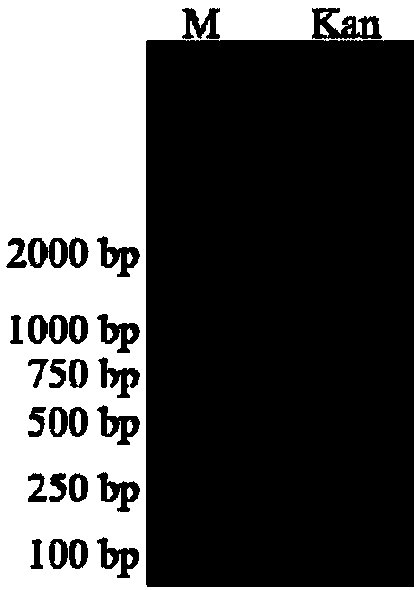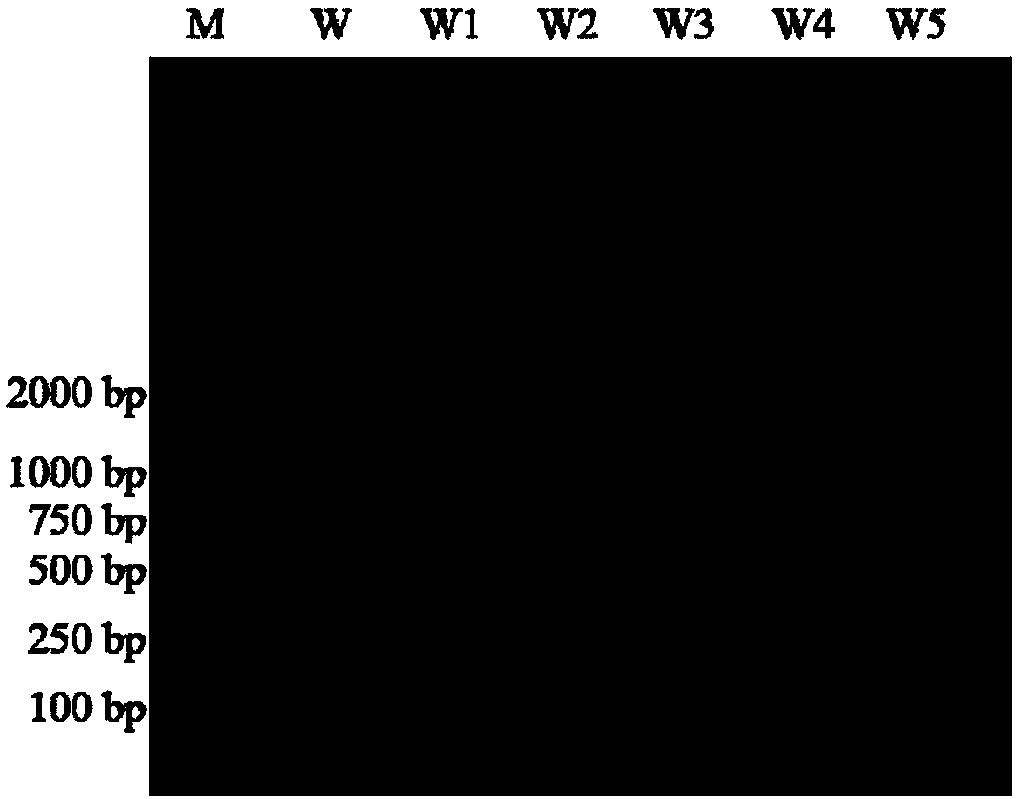Plasmid transforming method
A plasmid and fragment technology, applied in the fields of molecular biology and genetic engineering, can solve the problem of low plasmid transformation efficiency, and achieve the effect of improving transformation efficiency and high transformation efficiency.
- Summary
- Abstract
- Description
- Claims
- Application Information
AI Technical Summary
Problems solved by technology
Method used
Image
Examples
Embodiment 1
[0040] 1. PCR amplification of the exogenous linear targeting fragment containing the kana resistance gene for knocking out the ygiZ gene:
[0041] (1) Using the plasmid pKD4 containing the Kanak resistance gene as a template, use primers K-ygiZ-F and K-ygiZ-R to amplify the Kanak resistance gene linear targeting fragment "homologous arm + FRT + Kan Sequence+FRT+homology arm", after the amplification is completed, it is detected by 1% agarose gel electrophoresis.
[0042] The amplification system is shown in Table 1.
[0043] Table 1 PCR system of exogenous kana resistance gene linear targeting fragment
[0044] Reagent name
volume
5×prime STAR buffer (Mg 2+ +plus)
10 μL
dNTP mixture (2.5mM each)
4μL
K-ygiZ-F
1μL
K-ygiZ-R
1μL
template
1μL
Primer STAR HS DNA polymerase (2.5units / μL)
0.5μL
Sterilized distilled water
Up to 50μL
[0045] (2) PCR amplification conditions: pre-denatura...
Embodiment 2
[0071] (1) Loss of the recombinant strain E.coli DH5α::Kan::△ygiZ Kanna resistance fragment (also can be understood as: deletion or knockout)
[0072] The temperature-sensitive plasmid pCP20, which can encode the recombinant protein FLP, was introduced into the correctly identified E.coliDH5α::Kan::△ygiZ recombinant strain by electroporation, revived and cultured at 30°C and 150r / min for 1 hour, and 200 μL was spread on the containing 35 μg / mL chloramphenicol on LB plate medium, cultured at 30°C for 8 hours, then increased to 42°C for overnight culture, heat-induced expression of FLP recombinase, and plasmid loss.
[0073] (2) Screening and identification of mutant strain E.coli DH5α::△ygiZ
[0074] Use a sterile toothpick to randomly pick 5 single colonies grown on the chloramphenicol plate, and inoculate each single colony on the chloramphenicol plate, the ampicillin plate and the plate without antibiotics, and culture at 37°C for 12-16 hours. The colony that can only grow ...
Embodiment 3
[0083] Determination of Transformation Efficiency of Mutant Strain E.coli DH5α::△ygiZ
[0084] with 100mM CaCl 2 Prepare wild-type E.coli DH5α and mutant strain E.coli DH5α::△ygiZ competent cells respectively, and dilute plasmids pUC19, pET-32a, p1304 to 5ng / μL. Take 2 μL and add them to 100 μL of the two competent states, mix gently, and ice-bath for 30 minutes. Heat shock at 42°C for 90s, ice-bath for 2min, then add 900μL LB culture medium and re-incubate at 37°C for 50min at 180r / min. Take 100 μL and spread on LB plate respectively, culture overnight at 37°C and count.
[0085] Transformation efficiency = (number of plate colonies × dilution factor) / plasmid mass (ng)
[0086] The result is as Figure 4-Figure 7 As shown, the results show that the transformation efficiencies of the competent cells of wild-type E.coli DH5α and mutant E.coli DH5α::ΔygiZ to plasmid pUC19 are 2.58×10 6 CFU / μg and 5.28×10 6 CFU / μg;
[0087] The transformation efficiency of plasmid pET-32...
PUM
 Login to View More
Login to View More Abstract
Description
Claims
Application Information
 Login to View More
Login to View More - R&D
- Intellectual Property
- Life Sciences
- Materials
- Tech Scout
- Unparalleled Data Quality
- Higher Quality Content
- 60% Fewer Hallucinations
Browse by: Latest US Patents, China's latest patents, Technical Efficacy Thesaurus, Application Domain, Technology Topic, Popular Technical Reports.
© 2025 PatSnap. All rights reserved.Legal|Privacy policy|Modern Slavery Act Transparency Statement|Sitemap|About US| Contact US: help@patsnap.com



